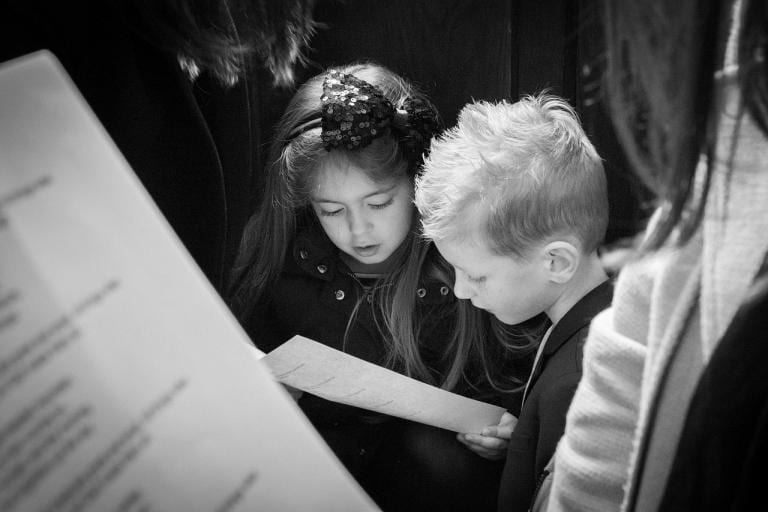 Them: I like traditional worship, but I’ve got kids, so, you know…
Them: I like traditional worship, but I’ve got kids, so, you know…
Me: No, I don’t. What do you mean?
Them: Well…I’ve got to have them in contemporary worship.
Me: Oh. Why?
Them: (With increasing annoyance) Well…you know…they’re kids!
I must have had this conversation a thousand times. These are parents, who usually for the most honorable of reasons believe that they need to put their kids in contemporary worship. After all, it’s easy, it seems relevant, and it doesn’t ask for much in return.
The motivation may be pure, but the method is short-sighted, and the results can be disastrous.
I think in the haste to see their kids “connected” or “plugged in” to the church, it’s easy for parents to forget a few things about the purpose of corporate worship.
Parents must remember the formative, educational function of worship.
Corporate worship isn’t supposed to be easy. It’s hard. It’s tough. It’s demanding. Of course, so is everything that is worth doing, that can have a lasting impact on our lives. We understand this when it comes to formal education, don’t we? Kids are confronted with new and difficult concepts, not because it will be fun (though hopefully this is sometimes the case), but because it’s good for them. The rewards may not be immediate, but our kids will be more equipped to meet the world as adults.
Isn’t it about time we realized the same is true when it comes to corporate worship? It can be exceedingly difficult, but in the end, it will prepare them so much more fully for a life of faith and service.
Parents must be willing to model.
I saw the most beautiful thing at one of the Christmas Eve services I participated in last year. There was a couple who brought four young children and sat on the front row. I’m not sure the parents looked up to the chancel at any point during the whole service except for a few fleeting glances during the sermon. They were always involved with their kids. When the rest of us stood and sang, they stooped, hymnals open, fingers underlining the text for the little eyes to follow. When we passed the peace, Mom led her daughter to an elderly lady nearby. I was just close enough to hear the small, high-pitched, “Peace be with you” that accompanied the tiny, outstretched hand. At the offertory, everybody had a contribution in hand awaiting the plate. Whenever attention waned, as it inevitably did, positive redirection followed.
For these parents, though it might have made for a tough hour, their leadership was in and of itself an act of worship. And as for their children, they were opening up to the joy and responsibility of full participation in the central act of the church.
Parents must reject the stereotypes that sell young people short.
Kids, I don’t know what’s wrong with these kids today.
Kids, who can understand anything they say?
Kids, they are disobedient, disrespectful oafs
Noisy, crazy, sloppy, lazy, loafers
And while we’re on the subject
Kids, you can talk and talk till your face is blue
Kids, but they still do just what they want to do
Why can’t they be like we were, perfect in every way?
What’s the matter with kids today?
To be honest, I see a generation that is crying out for the sustenance that traditional worship can bring. For boundaries, for beauty, for connection to something bigger than themselves. Their faith is parched for corporate worship that will last, that will sustain.
The temptation to deride the folly of youth isn’t new. And it too easily becomes self-fulfilling prophecy.
As a former educator, I think Lady Bird Johnson’s observation that children are “apt to live up to what you believe of them” still rings true. One of the lies of contemporary commercial worship is that modern entertainment is the only way to engage the fleeting attention span of our youngest worshipers. The point of corporate worship isn’t to hook them with trappings of supposed cultural relevance, but to dedicate their lives to the glory of God, and be transformed by the sacred storytelling of Word and Sacrament
Welcome children (and their families) with open arms into liturgy.
If you want future generations to experience the life-giving beauty of traditional worship, you have to extend plenty of grace to children and families. Kids are not always going to behave themselves perfectly, and we need to get over it. This isn’t to say that we tolerate all forms of misbehavior, but a momentary lack of understanding could irreparably damage budding the budding faith on the pew behind us.
Forget the sentimentality.
The self-imposed contemporary/traditional worship dichotomy has had far-reaching negative effects on traditional worship. Instead of being a place for multi-generational participation, it’s been labeled as “old people worship and turned into a self-indulgent, “get all your blue-haired friends together” all-request golden oldies hour. That’s a dangerous, toxic practice that is not only self-indulgent, but foreshadows it’s own imminent death. “Traditional” shouldn’t imply “old.” It should include both old and new elements in an expression of faith that is rooted in history, supported by the historic liturgical framework, but always looking forward.
Stop overstimulating and engage kids through liturgy.
We’ve known for quite a long time that it is possible to capture children’s attention with visual media, particularly when it’s loud, flashy, and fast-paced. But we also know now more than ever how harmful it is for small children to become dependent on technology. School districts have learned this the hard way – in a way, technology can make learning fun, but it comes with a price. Children are now unable to learn without it. This dependency is seen in churches, as well, and now affects adult congregants. The bright, shiny objects can in some cases make church a bit more entertaining, but it creates a dependence. What you attract people with you attract them to. We’ve seen this time and time again, but the modern church has apparently not yet learned its lesson. In making church entertaining, we’ve dug a massive hole and thrown our children into it.
Instead of feeding the media dependency, become participatory. Become liturgical. Reject the increasing emphasis on long sermons and passive services. Expect children to say words they don’t understand and sing hymns they don’t immediately connect with. Introduce them into the beauty and drama of the church year. Instead of fashioning worship to compete with all the other activities and entertainment options, introduce them to a transcendent rhythm that can shape their life as a people set apart. This will be exceedingly difficult. It is not a quick fix to the shrinking church. It’s much easier to distract them with prepackaged entertainment. But in the end, it’s worth it.
Tear down silos in our congregations.
Specifically, we’ve got to arrange our Sunday schedule to allow children and youth to participate in corporate worship. A lot of churches, operating under the assumption that families will only dedicate one hour to the church on Sunday morning, have intentionally built up a Sunday School wall. Adults go to “worship,” which is often merely a time of entertaining music and some sort of preaching or teaching, while kids go to their own activities. Not only are we denying our entire church family the privilege of worshiping together, we’re denying our children the opportunity to develop connections with the greater life of the church that will last after they’ve graduated from the last age-specific church program. Is it any wonder that kids are leaving the church faster than ever?
Maybe it’s time to reconsider the notion that young people need to be able to have “their” worship.
Yes, it may be easier to hook them with commercial music and pervasive media, but we’re not doing them any favors in the process. And, of course, as with all forms of entertainment, eventually the effects will wear off, and our bright, shiny objects will have to get bigger, brighter, and shinier. And that’s a pretty tough road for the church to travel.













